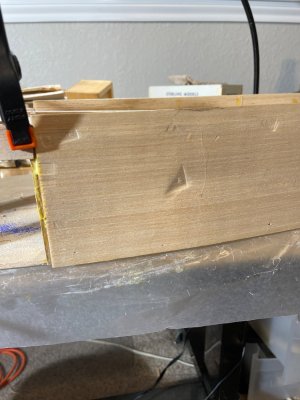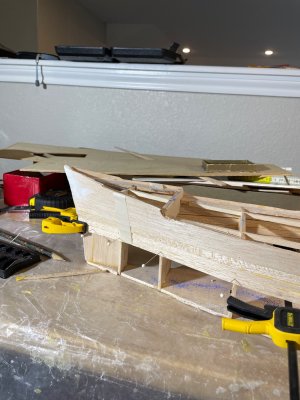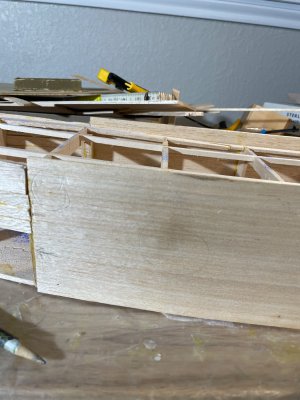-

Win a Free Custom Engraved Brass Coin!!!
As a way to introduce our brass coins to the community, we will raffle off a free coin during the month of August. Follow link ABOVE for instructions for entering.
You are using an out of date browser. It may not display this or other websites correctly.
You should upgrade or use an alternative browser.
You should upgrade or use an alternative browser.
It was there. Just a little to the left. I had to put the clamp at an angle.
Good afternoon Vic. This drives me nuts and I still do it…. Never learnOops! The clamps made dents in the balsa. Time to buy some wood putty. I tried using pins, but they didn’t hold. Next time I’ll use plywood sheets to even out the pressure. View attachment 533264
 . Cheers Grant
. Cheers GrantI’m just glad it will all be covered, Grant!Good afternoon Vic. This drives me nuts and I still do it…. Never learn. Cheers Grant
Like I said... BALSA!Good afternoon Vic. This drives me nuts and I still do it…. Never learn. Cheers Grant
Yep. I just tried masking tape and that seemed to work okay. I just bought some epoxy and fiberglass. I'll test it out on some soft wood to see how it works. Never used it before. Supposedly it will make it stronger.Like I said... BALSA!
i presume there was no frame under that section of the hull skin were the clamp was? why not use masking tape to hold the balsa skin in place till the glue dries instead of the clamps?
Epoxy and fiberglas will make a hard skin on the wood, but it's STILL balsa.Yep. I just tried masking tape and that seemed to work okay. I just bought some epoxy and fiberglass. I'll test it out on some soft wood to see how it works. Never used it before. Supposedly it will make it stronger.
- Joined
- Jun 29, 2024
- Messages
- 1,415
- Points
- 393

A tip. I learned this the hard way! Don’t try to glue the fiberglass cloth on to the model with the epoxy. If you do you will wind up with a wrinkled mess. The correct way is to first drape the cloth over the model and then apply the epoxy, working it into the weave of the cloth with a squeegee.
Roger
Roger
A just saw a video on that. I’ll watch it again a couple of times and then practice on a piece of plywood.A tip. I learned this the hard way! Don’t try to glue the fiberglass cloth on to the model with the epoxy. If you do you will wind up with a wrinkled mess. The correct way is to first drape the cloth over the model and then apply the epoxy, working it into the weave of the cloth with a squeegee.
Roger
Kurt Konrath
Kurt Konrath
Try wetting area and heating with plank bender or similar tool to heat wood, often the fibers relax and dent comes mostly out.Oops! The clamps made dents in the balsa. Time to buy some wood putty. I tried using pins, but they didn’t hold. Next time I’ll use plywood sheets to even out the pressure. View attachment 533264
I have a feeling that might be especially true with balsa.Try wetting area and heating with plank bender or similar tool to heat wood, often the fibers relax and dent comes mostly out.
- Joined
- Jun 29, 2024
- Messages
- 1,415
- Points
- 393

Based on the comments above it appears that we are discussing and possibly confusing two separate and distinct problems; the dents in the hull, and the fiberglass and epoxy.
First, glassing the entire hull “box” will strengthen it. For this to work you need a good bond between the glass and balsa. This is dependent on your technique as we have already discussed.
Next, glassing will NOT fill voids in the hull like the dents from your clamps. To get a good bond between glass and balsa, the hull needs to be free from such blemishes. They should be filled with something generally known as “putty.” This covers a wide range of materials from homemade mixes of PVA glue and sawdust to special thickened epoxy fillers. Here again balsa prevents a special problem as it is so much softer than many fillers including my favorite Durham’s “Rock Hard” Water Putty. You need to find something that can be sanded smooth without damaging the surrounding balsa.
Last, glassing is not for the faint of heart, especially since your model is already so fragile. As this model is to be used as a piece scenery let me suggest an easier solution that I have used for a steamship model that I am currently building. Plate the hull with quality bond paper saturated with shellac (let it dry) and glued to the hull with PVA woodworking glue. The glued paper is surprisingly durable and will harden the soft balsa surface. Easy, quick and foolproof.
First, glassing the entire hull “box” will strengthen it. For this to work you need a good bond between the glass and balsa. This is dependent on your technique as we have already discussed.
Next, glassing will NOT fill voids in the hull like the dents from your clamps. To get a good bond between glass and balsa, the hull needs to be free from such blemishes. They should be filled with something generally known as “putty.” This covers a wide range of materials from homemade mixes of PVA glue and sawdust to special thickened epoxy fillers. Here again balsa prevents a special problem as it is so much softer than many fillers including my favorite Durham’s “Rock Hard” Water Putty. You need to find something that can be sanded smooth without damaging the surrounding balsa.
Last, glassing is not for the faint of heart, especially since your model is already so fragile. As this model is to be used as a piece scenery let me suggest an easier solution that I have used for a steamship model that I am currently building. Plate the hull with quality bond paper saturated with shellac (let it dry) and glued to the hull with PVA woodworking glue. The glued paper is surprisingly durable and will harden the soft balsa surface. Easy, quick and foolproof.
I do have some epoxy putty that I am about to use. I also bought some resin and glass. I will practice on some scrap wood to see how it works. If that doesn’t work, I’ll drop back and punt.
This is a learning experience for me. I get to try some new things.
I will also say thanks to Kurt Konrath. I did not know about wetting and heating the area of dented balsa. In my ship yard the only place for balsa is in filling bow and stern blocks to get an exact shape before fibreglassing. Weight is never a problem with my ship models, but strength and durability is, therefore balsa sheeting is only used in building my aircraft where weight is always a consideration.
This would pretty much be a scratch build if it weren’t for the balsa. Because of the size, it would also be cost prohibitive to replace the balsa. This is what the owner wants. The kit was a Christmas gift to him. I will do the best I can and try to make it as strong as I can in the process.I will also say thanks to Kurt Konrath. I did not know about wetting and heating the area of dented balsa. In my ship yard the only place for balsa is in filling bow and stern blocks to get an exact shape before fibreglassing. Weight is never a problem with my ship models, but strength and durability is, therefore balsa sheeting is only used in building my aircraft where weight is always a consideration.







